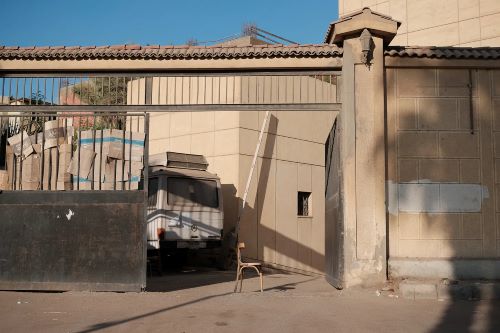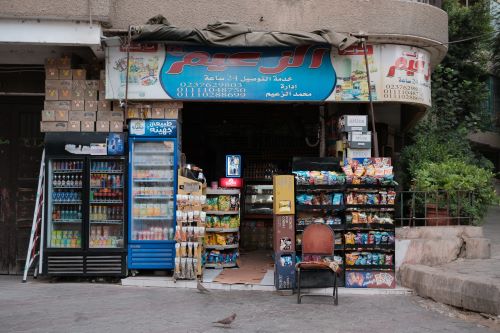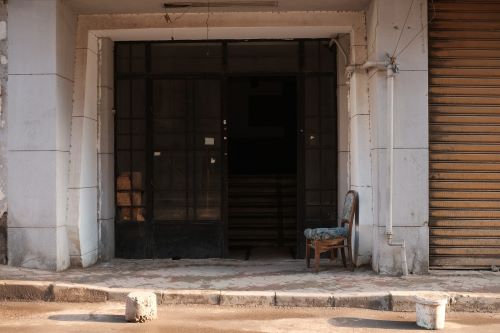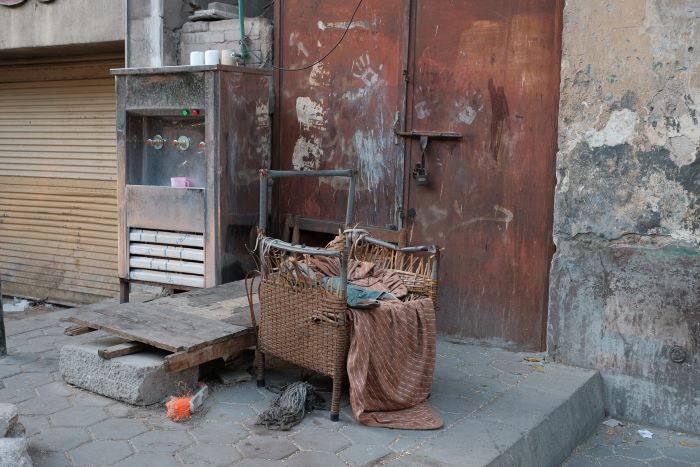I’ve lived most of my life in the same Cairo neighbourhood and last week I discovered something new while walking around taking photos: chairs.
I’m in Cairo for a short trip so I want to take advantage of that time to take some photos. I wake up early and venture out in my own neighbourhood. A few minutes into the walk, I see this chair and I find it funky enough to be a subject. Not too far, I stumble on a second chair: this time less funky but equally poetic. It’s a simpler design but I like its position between the bright wall and the dark building entrance.
In that moment, I am reminded of Susanne Helmert’s all they left was a chair, a photo series paying homage to chairs left in abandoned buildings. Although these Cairo chairs can also look abandoned, they are very much alive. It’s 7am in a city that is up all night so they are all temporarily empty. Soon enough, these same quiet streets will be buzzing with a near constant symphony of car horns. The more I walk, the more empty chairs I find in the street and it dawns on me that these aren’t isolated coincidences. The streets are filled with chairs waiting to serve a population that lives outdoors. How could I have lived here for years without realizing this mystery?

A few weeks ago, I wrote about the lost art of hanging out. I am not so sure it’s lost. These chairs represent a cultural aspect of Cairo: people are often in the street. Streets aren’t just a way to get from point A to point B but an end themselves. Hang out on any street in Cairo for some time and you will realize that it has its regulars: a mix of people who are there day in and day out. They can be doormen, guards, shopkeepers, or professional chillers, and predominantly male. Women’s unequal presence, or absence, on Cairo’s street chairs reveals the city’s gender dynamics. It’s the less poetic part of my sudden interest in chairs. The street becomes an extension of the living room, or of shops, at least for half of the population whose presence is accepted. A striking reminder of the progress left to make.

The chairs come in all shapes and sizes, and although I didn’t try any of them, I can tell they have varying degrees of comfort. I went out to take photos two days in a row, for around an hour each day, and I have a photo of 30 chairs. These chairs turned into the theme of those walks. I think that my fascination isn’t so much about the chairs themselves but about the fact that I had never noticed them. After all, mindful photography is about noticing more, so I guess it’s working.
I started writing the paragraphs above without knowing where this was going, trusting the process through my self-doubt: I can’t possibly write a whole post on chairs I thought. And sure enough, here we are. Just as I thought I was making chairs into a bigger deal than they are, I discovered I was not alone. Between 2012 and 2015, Manar Moursi and David Puig had been photographing chairs in Cairo and have a collection of over 1000 polaroids that come together in their project 1001 chairs. The discovery leaves me feeling ambivalent: I am impressed and excited by the brilliance of Manar and David’s project, but my bubble as the sole creative genius who had noticed the significance of Cairo’s chairs is burst. They also saw the culture significance of these chairs scattered around Cairo. In this insightful article where they write about their own feelings towards these chairs, they describe a dichotomy:
At first sight, empty chairs seem always inviting. They bring to mind a person with open arms, a temporary shelter: a comma to breathe in the middle of an extenuating sentence. This is particularly true of chairs next to kiosks where clients sit and chat while they sip a soda before continuing their journeys.
But other chairs are closer to full stops than commas. At the entrance of a building, a lonely chair can be a warning: an urban scarecrow positioned as an imaginary surveillance camera. Personifying the doorman, it reminds any eventual intruders that someone might be watching them.

Ah, the doorman, an iconic figure of Egyptian culture, the gatekeeper of every building, exemplified by the sayingهى وكالة من غير بواب. Literally translated to “It is an agency without a doorman” and used to refer to a place where anyone can just walk in. Not if there’s a chair, you won’t.
Holding strong through transfers of ownership and trips across the city or country, they carry the signs of chairs that have been used fully. Chairs that have been well sat on. Like these repaired chairs getting a second life, I gained a new understanding of my city through them. These largely unnoticed everyday objects turned out more fascinating than I thought.
More photos of chairs to come next week!




